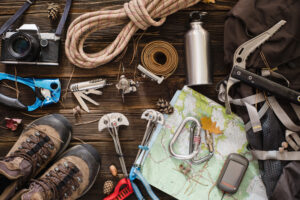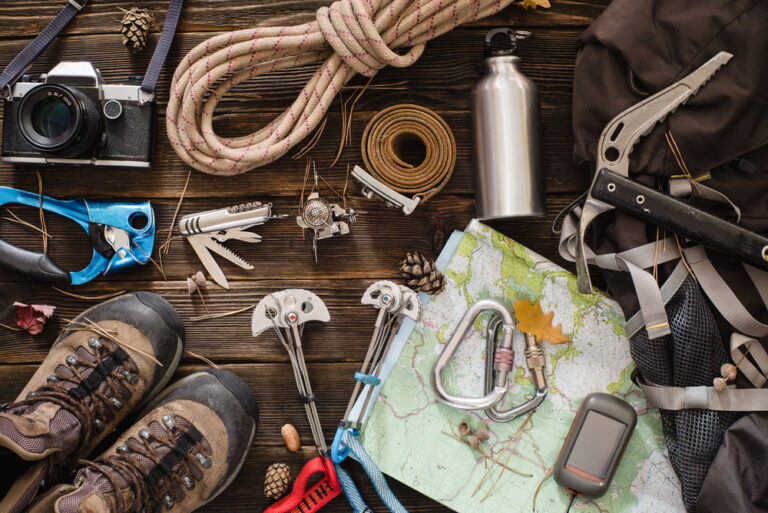1. Why Climbing Accessories Define Your Safety and Success
Whether you’re scaling a local crag or attempting a Himalayan summit, climbing accessories form the invisible backbone of every adventure. These items—ranging from carabiners to chalk bags—bridge the gap between safety and performance. Without the right gear, even skilled climbers risk unnecessary danger.
Climbing accessories aren’t luxuries—they’re your lifeline. High-quality climbing gear ensures stability, comfort, and confidence. From harnesses that prevent falls to helmets that shield against rock impacts, the right tools make the difference between a thrilling ascent and a hazardous one.
2. Harnesses: The Core of Your Climbing Setup
Among all climbing accessories, the harness is arguably the most crucial. It connects you directly to the rope, the belay system, and, ultimately, your partner’s trust. Look for features like adjustable leg loops, breathable padding, and reinforced tie-in points.
Modern harnesses such as the Petzl Sitta or Black Diamond Solution provide lightweight comfort without sacrificing durability. A good harness balances mobility with security—especially vital for multi-pitch or lead climbing.
3. Carabiners: Small Tools with Massive Responsibility
Carabiners may seem minor, but in climbing accessories, they’re the unsung heroes. These metal connectors bear your body weight, anchor systems, and safety gear.
Opt for locking carabiners when belaying or rappelling, and non-locking carabiners for gear organization. Aluminum options save weight, while steel offers maximum strength. Always inspect carabiners for wear, sharp edges, and gate function—because one faulty clip can end an adventure.
4. Belay Devices: The Art of Controlled Descent
Belay devices transform the climbing experience from dangerous to manageable. These critical climbing accessories control the rope during belays and rappels.
The ATC Guide and Petzl GriGri 2 remain top favorites. Tube-style devices provide versatility, while assisted-braking models enhance safety, particularly for beginners. Whichever you choose, ensure compatibility with your rope’s diameter for smooth feeding and braking.
5. Climbing Shoes: Precision at Every Step
No list of climbing accessories is complete without climbing shoes. The right pair offers friction, sensitivity, and support across rock surfaces.
Choose aggressive shoes (like La Sportiva Solution) for overhangs, neutral shoes for long trad routes, and moderate shoes for versatility. Always prioritize fit—tight enough for control, yet comfortable enough for endurance.
Your feet are your foundation. Treat them like precision tools.
6. Helmets: Protecting What Matters Most
A helmet is among the few climbing accessories that should never be optional. Falling debris, swinging gear, or accidental bumps against the wall—all pose real risks.
Lightweight, well-ventilated helmets like Petzl Meteor or Black Diamond Vision provide crucial protection. Always check for certifications (UIAA/CE) and replace helmets after major impacts.
7. Chalk and Chalk Bags: Grip That Builds Confidence
Sweaty palms and slippery holds can spell disaster. That’s why chalk remains one of the simplest yet most essential climbing accessories.
Use magnesium carbonate chalk to dry your hands and maintain friction. Pair it with a secure, easily accessible chalk bag that doesn’t swing uncontrollably. For indoor climbers, chalk balls or liquid chalk are less messy alternatives.
8. Climbing Ropes: Your Lifeline on Every Route
A climbing rope isn’t just another piece of gear—it’s your literal lifeline. Among all climbing accessories, few demand such scrutiny.
Choose dynamic ropes for lead climbing and static ropes for rappelling or hauling gear. Key specifications include rope diameter, weight per meter, and fall rating. Trusted brands like Mammut, Sterling, and Edelrid produce ropes that meet UIAA safety standards.
9. Quickdraws: Efficiency Meets Safety
Quickdraws connect your rope to the wall’s protection points, reducing fall distances. A must-have in your climbing accessories kit, these tools combine two carabiners linked by a durable sling.
Select nylon dogbones for durability and Dyneema slings for lightweight performance. Always ensure the rope-end carabiner is bent-gate for smoother clipping.
10. Cams and Nuts: Anchoring Confidence in Every Crack
Traditional climbers rely on cams and nuts—mechanical and passive protection devices that fit into rock cracks to prevent long falls. These climbing accessories require skill and judgment.
Brands like Black Diamond, DMM, and Wild Country offer precision-engineered options that expand and grip rock with remarkable reliability. When placed correctly, cams become an extension of your courage.
11. Slings, Webbing, and Cordelettes: Versatile Multi-Tools
These flexible climbing accessories serve countless purposes—building anchors, extending protection, or creating personal tether systems.
Dyneema slings excel in weight and strength ratio, while nylon webbing provides stretch and durability. Always double-check for wear, especially around knots or carabiner contact points. A worn sling can be deceptively dangerous.
12. Personal Anchor Systems (PAS): Safety Meets Convenience
A Personal Anchor System (PAS) provides a secure way to clip into anchors at belay stations. These climbing accessories streamline transitions and reduce knot clutter.
Modern PAS models like Metolius Dynamic PAS offer dynamic stretch to absorb minor shock loads, enhancing both safety and efficiency. Think of it as a climber’s seatbelt—simple but lifesaving.
13. Climbing Packs: Carry Smart, Climb Better
A climber’s pack isn’t just for storage—it’s for systemization. These climbing accessories keep your essentials organized and balanced.
Look for hydration-compatible packs with gear loops, compression straps, and ventilated back panels. Top models like Osprey Mutant 38 or Deuter Guide 34+ combine durability with ergonomic comfort.
14. Maintenance Tools and Accessories: Extending Gear Life
Carrying a small maintenance kit helps prolong the lifespan of your climbing accessories. Include a knife, tape, brush, and gear cleaning solution. Regular inspection prevents micro-cracks or weakened fibers from turning catastrophic mid-climb.
15. Choosing Climbing Accessories That Match Your Goals
The best climbing accessories are those aligned with your style—sport, trad, bouldering, or ice climbing. Evaluate based on:
-
Durability (how long it lasts)
-
Weight (critical for long ascents)
-
Functionality (does it make your climb safer or smoother?)
-
Fit and compatibility (how it works with your other gear)
Investing in premium equipment pays dividends in confidence, safety, and success. Cheap gear costs more when it fails.
16. Final Thoughts: Equip Your Passion Responsibly
Climbing accessories don’t just support your physical ascent—they symbolize preparation, mindfulness, and respect for nature. Every rope, carabiner, and helmet represents trust in your own discipline and your climbing partners.
Equip wisely. Climb fearlessly. And remember: true mastery isn’t just about reaching the summit—it’s about doing it safely and sustainably.




